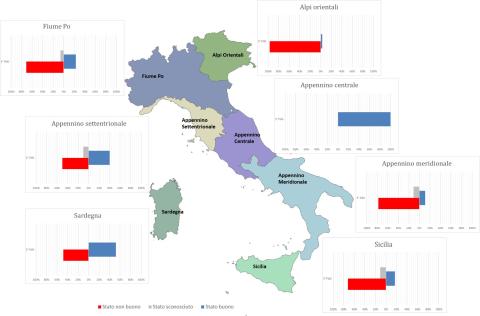Panel 1
Valentina Bernarello, Federica Cacciatore
The legislation (Legislative Decree 152/2006) mandates achieving good status of water bodies (chemical + ecological) by the deadlines established by the current legislation. The analysis of chemical status shows heterogeneous values among the districts, with 100% of water bodies in good status only for the Central Apennines and 52% for Sardinia. In all other districts, the percentage of water bodies in good status never exceeds 50% and ranges from 3% in the Eastern Alps to 40% in the Northern Apennines.
A comparison between the status in the 2nd Water Management Plan (WMP) cycle and that in the 3rd cycle shows maintenance of good chemical status for 100% of the water bodies in the Central Apennines, an improvement for those in the Northern Apennines (from 30% to 40%), Sardinia (from 12% to 52%), and Sicily (from 11% to 17%), and a worsening for the water bodies in the Eastern Alps District (from 51% to 3%), Po River (from 65% to 23%), and Southern Apennines (from 18% to 11%).
At the national level, the number of water bodies in good status is 56 out of 172 (33%) in the 2nd WMP cycle, while in the 3rd cycle it is 42 out of 146 (29%).
The definition of the chemical status of transitional waters (good or not good) is based on the assessment of the presence of pollutants to be detected in water, sediments, and/or biota (the latter two matrices made mandatory for certain substances with Legislative Decree 172/2015), designated as "priority" and "priority hazardous" substances, with related Environmental Quality Standards (EQS), which must not be exceeded in the water bodies for the purpose of classifying good chemical status.
To verify, every six years, the effectiveness of the programmes of measures implemented by the competent authorities to control pressures, and therefore the achievement of "good" status by the deadlines set by current legislation.
Directive 2000/60/EC, Legislative Decree 152/2006 and subsequent amendments. Directive 39/2013/EU (transposed by Legislative Decree 172/2015) introduced 12 new priority substances which will be considered in chemical status classification starting in 2027.
Panel 2
Legislative Decree 152/06 as amended and implementing decrees of Directive 2000/60/EC
WISE Reporting of the 3rd Water Management Plan of River Basin Districts (updated October 2022)
WISE Reporting of the 2nd Water Management Plan of River Basin Districts (updated October 2016)
Updating of substances, environmental quality standards (WFS) and analysis matrices
Data quality assessment
District Basin Authority, Coastal Regions, SNPA (National Environment Protection System)
Data extracted from the WISE Reporting of the 2nd Water Management Plan of River Districts (Update 2016) Data extracted from the WISE Reporting of the 3rd Water Department Management Plan (update 2022)
National
2010-2015, 2016-2021
Indicator assessment
The chemical data for each station contribute to the quality assessment of water bodies based on the "one out, all out" principle. With Law 221/2015, the boundaries of River Basin Districts were redefined; therefore, to allow comparison between the 2nd and 3rd Water Management Plan (WMP) cycles, the water bodies from the 2nd cycle were assigned to the Districts according to the new boundaries.
The analysis at the District level (Figure 1) shows heterogeneous values, with 100% of water bodies in good status for the Central Apennines and 52% for Sardinia. In all other districts, the percentage of water bodies in good status never exceeds 50% of the cases and ranges from 3% in the Eastern Alps to 40% in the Northern Apennines. Nationally, the number of water bodies in good status is 42 out of 146. It is worth noting significant percentages of unclassified water bodies in several districts.
The temporal coverage of the indicator does not currently allow the identification of a trend
Data
Figure 3: National chemical state of the bodies of the transitional water - comparison 2nd cycle (2015-2021) and 3rd cycle (2021-2027) of Water Management Plans
ISPRA processing on Reporting WISE data (October 2022 update)
PdG - Management Plan; colors determine the quality status as follows: Blue, Red, Not Good. Gray color identifies unclassified water bodies




Based on the data reported by the Districts in the 3rd Reporting to the European Commission for the 2016–2021 six-year period (updated October 2022), the chemical status of Italian transitional waters appears heterogeneous. This heterogeneity is evident both in the number of water bodies identified per District and in the results of the classification. Only the Central Apennines District has 100% of its water bodies in good status. In all other Districts, the percentage of water bodies in good status never exceeds 50% of the cases: except for 52% in the Sardinia District, in the others it ranges from 3% in the Eastern Alps to 40% in the Northern Apennines (Figure 1). With Law 221/2015, the boundaries of the River Basin Districts were redefined; thus, to compare the 2nd and 3rd WMP cycles, the water bodies from the 2nd cycle were assigned to Districts according to the new boundaries.
For a proper interpretation of the data, it should also be noted that Directive 39/2013/EU (transposed with Legislative Decree 172/2015) made it mandatory from 2018 to monitor certain parameters in biota for chemical classification, and not just in water. The Directive also introduced 12 new priority substances that will be considered in chemical status classification starting in 2027.
Comparison between the 2nd WMP cycle (2015–2021) and the 3rd cycle (2016–2027) shows maintenance of good chemical status (Figure 2) for 100% of water bodies in the Central Apennines, improvements for those in the Northern Apennines (from 30% to 40%), Sardinia (from 12% to 52%), and Sicily (from 11% to 17%), and worsening for the water bodies in the Eastern Alps District (from 51% to 3%), Po River (from 65% to 23%), and Southern Apennines (from 18% to 11%). At the national level (Figure 3), the number of water bodies in good status is 56 out of 172 (33%) in the 2nd WMP cycle, while in the 3rd it is 42 out of 146 (29%).